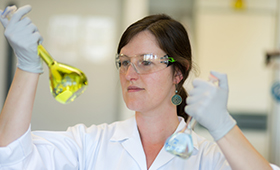Not always just a purely male domain
BIBB analysis of men and women in technical training occupations
15/2017 | Bonn, 20.04.2017

Despite numerous measures to increase the number of women training in technical occupations, the proportion has not increased in more than 20 years. The proportion of 12.4 percent in 2015 was at this level in 1993. These are the results of a current analysis by the Federal Institute for Vocational Education and Training (BIBB) looking at the differences between men and women in technical training occupations. BIBB's analysis was prepared for the forthcoming “Girls‘ and Boys‘ Day” which this year is being observed on 27 April.
Although the result makes for sobering reading in terms of numbers, it is nevertheless worth taking a closer look at the differences between men and women in technical training occupations. This is because, as shown in the BIBB analysis - which is based on VET statistics from the statistical offices of the Federal Government and federal states - “typically female” technical occupations definitely exist, even if it is just a few.
These include, for example, optician (proportion of women: 72 percent), biological laboratory technician (66 percent), designer of digital and print media (60 percent), dental technician (60 percent) and hearing aid audiologist (58 percent). The high proportion of women in these occupations in particular proves that, when choosing a technical training occupation, the majority of women prefer those with a health-related or creative focus.
By contrast, the predominantly “typical male” technical occupations all come from the production sector. Examples of these are agricultural and construction machinery mechatronics engineer, electronics technician, metal workers, information electronics technician and motor vehicle mechatronics technician. The proportion of men in these occupations is 96 to 99 percent.
The BIBB analysis also indicates a “training advantage” for women compared to men because women often have higher-level school-based prior learning. While, in the dual system, the proportion of those with qualifications for higher education in relation to the number of newly concluded training contracts is currently 27.7 percent, when differentiated according to gender the proportion among women increases to 34 percent while the proportion of men falls to 24 percent. When we consider only technical occupations, the disparity between men and women becomes even greater as here the proportion of women with qualifica-tions for higher education is 44 percent, for men it is 23 percent).
Traditionally, there are more men in the dual vocational education and training system than women (approximately 60:40), in particular because industrial and technical occupations have greater significance here. The opposite applies in terms of school-based vocational education and training in the occupations of health education and social welfare. These are selected by women in more than three quarters of all cases.
Background information
For the BIBB, “technical training occupations” include those whose activity and knowledge profile contains a high proportion of technology, for example high proportions of monitoring, and controlling of machines, systems and technical processes.
A graphic showing “typical female“ and “typical male” technical occupations is also available to download free of charge at www.bibb.de/pressefotos.
Specimen copy requested if printed.